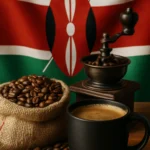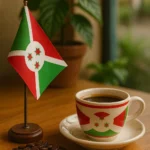You can explore many origins and tastes in specialty coffee. Rwandan Coffee stands out among East African coffees. It has bright acidity, delicate floral and fruity notes, and a smooth body. These qualities make it unique. Here, you will learn about its flavor, history, growing regions, processing, and sustainability. This information helps any coffee lover.
- What is the distinctive flavor profile of Rwandan Coffee?
- What is the brief history of coffee in Rwanda?
- What are the prime coffee-growing regions of Rwandan Coffee?
- What are the processing methods crafting Rwandan Coffee’s flavor?
- How does Rwandan Coffee compare to other East African varieties?
- What are the sustainability and farmer livelihoods initiatives in Rwandan Coffee?
- What makes Rwandan Coffee a valuable choice for coffee enthusiasts?
- Rwandan Coffee: A quick overview
What is the distinctive flavor profile of Rwandan Coffee?
Rwandan Coffee has a bright, vibrant acidity. It has a medium body and complex floral and fruity notes. This creates an elegant cup many people seek.
You often find bright citrus notes like lemon, orange, or berries. Delicate floral aromas, like rose, complement these. People compare these floral notes to Ethiopian Yirgacheffe Coffee. Sweetness underlies these notes—think caramel or cane sugar. Subtle spices like clove or cinnamon often add to its complexity. The coffee has a medium, smooth, creamy, sometimes buttery mouthfeel. It finishes clean and elegant. The Bourbon Arabica variety gives it these floral and complex notes.
What is the brief history of coffee in Rwanda?
German missionaries brought coffee to Rwanda in the early 1900s. Under Belgian colonial rule, coffee production became mandatory. The focus was on quantity, not quality.
The 1994 genocide devastated the country, disrupting infrastructure and the economy. A global coffee market crash in the 1990s added more challenges for Rwandan coffee. Rwanda revitalized its industry. Strategic national plans, government support, and international funding helped. Today, coffee is the country’s fourth-largest export. It supports about 400,000 smallholder farmers. Major markets include the United States, Switzerland, the United Kingdom, Belgium, and Singapore. Most coffee ships as green beans. Roasted bean exports started in 2018.
What are the prime coffee-growing regions of Rwandan Coffee?
Rwandan Coffee grows in five main regions:
- Lake Kivu,
- Virunga Mountains,
- Kizi Rift,
- Muhazi,
- Akagera.
These areas have unique conditions for quality coffee. Think fertile volcanic soils, high altitudes—1,200 to over 2,000 meters—and plenty of rain. Moderate temperatures also help. This environment lets coffee cherries mature slowly. Slow maturation develops complex sugars and flavors.
What characterizes the Lake Kivu Coffee Region for Rwandan Coffee?
The Lake Kivu Coffee Region is Rwanda’s largest and most productive. It sits in western Rwanda, bordering the Democratic Republic of Congo. Farms here are typically 1,400 to 1,900 meters high.
Volcanic soil and rolling hills around Lake Kivu give the coffee unique flavors. You’ll find a full body, complex tastes. Expect buttery toffee caramel, subtle citrus, and red berries. Darker roasts show earthy chocolate notes. Key districts in this region include Gisenyi, Nyamasheke, Kibuye, Cyangugu, and Butare.
What characterizes the Virunga Mountains Coffee Region for Rwandan Coffee?
The Virunga Mountains Coffee Region is in Northern Rwanda. It has some of the highest coffee altitudes, often over 2,000 meters. High altitudes, a cool, rainy climate, and mineral-rich volcanic soil produce rich coffees.
Coffees from here are often naturally sweet with strong floral notes. They add to the variety of Rwandan Coffee.
What characterizes the Kizi Rift Coffee Region for Rwandan Coffee?
The Kizi Rift Coffee Region sits in southwest Rwanda. It is next to the Nyungwe forest and Virunga volcanic mountains. Altitudes here range from 1,550 to 2,150 meters. These conditions are ideal for complex coffee.
Plenty of rain and nutrient-rich soils produce complex flavors. You might taste bright sweet orange, cherry, lime, and clear cocoa notes.
What characterizes the Muhazi Coffee Region and Akagera Coffee Region for Rwandan Coffee?
The Muhazi Coffee Region, near Lake Muhazi, and the Akagera Coffee Region in eastern Rwanda add to the country’s coffee diversity. Both have good growing conditions, like volcanic soils and moderate altitudes.
They bring richness and variety to Rwandan Coffee. Specific flavor details for these regions are less documented.
What are the processing methods crafting Rwandan Coffee’s flavor?
Two main methods shape Rwandan Coffee’s flavor: washed (wet) and natural (dry). Each method gives the coffee distinct qualities. They affect acidity, body, and flavor complexity.
What is the Washed Coffee Process for Rwandan Coffee?
The Washed Coffee Process, or wet process, is common for Rwandan Coffee. About 55-60% of it uses this method. It involves careful steps for clear flavor.
First, producers pulp the cherries, removing the outer fruit. Then, beans ferment in water tanks for 24-72 hours. This breaks down mucilage. After fermentation, workers wash the beans. They typically dry them on raised tables. This process creates a clean, bright, acidic coffee. It highlights the bean’s true qualities and origin characteristics.
What is the Natural Coffee Process for Rwandan Coffee?
The Natural Coffee Process, or dry process, is growing in popularity. It adds unique flavors to Rwandan coffee. This method dries the whole coffee cherry before extracting the beans.
Beans stay in contact with fruit sugars during drying. This gives the coffee more body, enhanced sweetness, and strong fruity or wine-like flavors. You get a memorable cup with a bold flavor.
What is the Semi-Washed Process for Rwandan Coffee?
The Semi-Washed Coffee Process is common among Rwanda’s small producers. It accounts for about 60-70% of home-processed coffee. This method mixes wet and dry processing.
It often removes some mucilage before drying. This creates a balanced cup. You get some cleanliness like washed coffees, plus the body and sweetness of natural processed beans.
How does Rwandan Coffee compare to other East African varieties?
Rwandan Coffee stands out among East African coffees. It has a unique mix of smoothness, balanced acidity, and complex aromas. It often feels smoother and creamier than other regional coffees.
Compared to Kenyan Coffee, Rwandan Coffee is smoother, creamier, and silkier. Kenyan Coffee is usually brighter, fruitier, and often wine-like. Rwandan Coffee shares delicate and floral qualities with Ethiopian Yirgacheffe Coffee. But Rwandan Coffee often has a richer caramel or chocolate aftertaste. Its high-altitude growth means slower bean maturation, which boosts sweetness and complexity. The country’s focus on quality means many award-winning lots. This builds its reputation as a fine specialty coffee. Even next to Zimbabwean Coffee, Rwandan Coffee keeps its distinct and celebrated flavor.
What are the sustainability and farmer livelihoods initiatives in Rwandan Coffee?
Rwanda works hard to promote sustainable farming. This helps Rwandan Coffee farmers earn more. These efforts include empowerment, training, technology, and certification.
Here are some key initiatives:
- Empowering women and youth coffee producers is key. Village Savings and Loans Associations (VSLAs) offer financial independence. They provide savings and low-interest loans. This lets farmers diversify income beyond coffee. It helps close the living income gap. It also improves nutrition for 3,425 people.
- Organizations like Matriarch Coffee promote sustainable and organic farming. This includes organic farming, reforestation, and water conservation. They train farmers and improve skills. They also work to lessen climate change impacts. Fair pricing and direct trade stabilize incomes.
- The Rwanda INC Project uses the Digital Farm Extension Management System (D-FEMS). This digital platform monitors regenerative farming practices. It integrates with government systems. This initiative nearly doubled the minimum cherry price for farmers from 2021 to 2024. This greatly improved farmer livelihoods.
- Certification programs are vital for market access and sustainability. Partnerships with Naturland, the Kahawatu Foundation, and Sucafina focus on certifications. These include Rainforest Alliance, Fairtrade, and Organic Certification. These programs use proprietary IMPACT Program Standards. They train farmers for certification. They also encourage regenerative practices. Emissions and supply chain sustainability are constantly monitored.
What makes Rwandan Coffee a valuable choice for coffee enthusiasts?
Rwandan Coffee is a valuable choice for you. It has a distinct flavor, remarkable resilience, and unique regions. Careful processing and strong sustainability efforts also play a role. It is high-quality, ethically produced specialty coffee. It offers more than just great taste.
Its bright acidity, complex floral and fruity notes, and smooth, creamy body tell a story. It is a story of unique land and dedicated work. The revival of the Rwandan Coffee Industry after big historical challenges shows Rwanda’s resilience. When you choose Rwandan Coffee, you support thousands of smallholder farmers. You help build a sustainable, fair coffee future. Taste the vibrancy of Rwanda. Find a specialty roaster selling Rwandan Coffee today. Discover your next favorite cup.
Rwandan Coffee: A quick overview
| Feature | Description |
|---|---|
| Flavor Profile | Bright acidity, floral, fruity, smooth, creamy body, often citrus, berry, caramel, spice notes. |
| History | Began early 1900s, quantity focus under Belgians, revitalized after 1994 genocide, now 4th largest export. |
| Key Regions | Lake Kivu, Virunga Mountains, Kizi Rift, Muhazi, Akagera. |
| Processing | Washed (clean, bright), Natural (full body, sweet, fruity), Semi-Washed (balanced). |
| Sustainability | Women & Youth empowerment, VSLAs, organic farming, D-FEMS, certifications (Rainforest Alliance, Fairtrade). |









